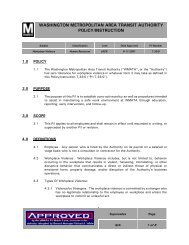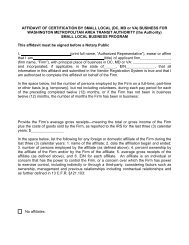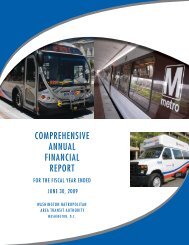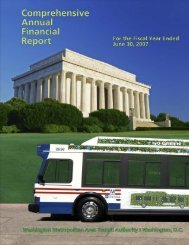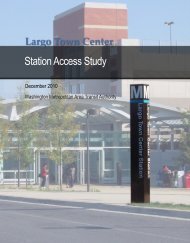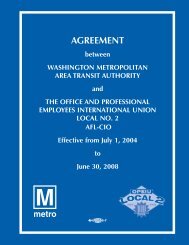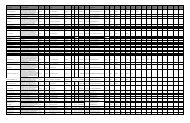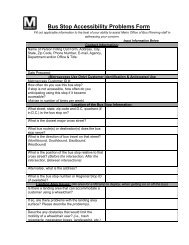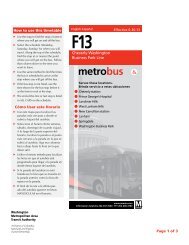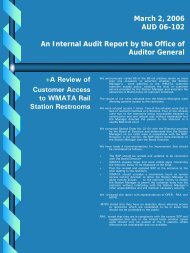Naylor Road Metro Station Area Access and Capacity - WMATA.com.
Naylor Road Metro Station Area Access and Capacity - WMATA.com.
Naylor Road Metro Station Area Access and Capacity - WMATA.com.
Create successful ePaper yourself
Turn your PDF publications into a flip-book with our unique Google optimized e-Paper software.
Future <strong>Station</strong> <strong>Access</strong> Needs<br />
The <strong>Naylor</strong> <strong>Road</strong> <strong>Station</strong> area is expected to undergo a wholesale transformation from an<br />
auto-centric transit station to a mixed-use, transit-oriented regional center with high-density<br />
housing, offices, <strong>and</strong> retail. Realizing this vision will take years, <strong>and</strong> this redevelopment process<br />
is just now beginning through <strong>com</strong>pleted or in-process planning studies tasked with improving<br />
the station area <strong>and</strong> its multimodal access. This report uses information <strong>and</strong> findings from<br />
these studies as well as additional station observations <strong>and</strong> analyses to define station access<br />
deficiencies <strong>and</strong> opportunities for improvement—or more simply, station access “needs.”<br />
Needs highlighted in this section are grouped by mode of access. The next section, <strong>Station</strong><br />
Re<strong>com</strong>mendations, summarizes re<strong>com</strong>mendations proposed in response to these defined needs.<br />
Pedestrian<br />
Twenty-nine percent more pedestrians <strong>and</strong> cyclists are estimated to access <strong>Naylor</strong> <strong>Road</strong><br />
<strong>Station</strong> by 2040 <strong>com</strong>pared to 2012, with pedestrians making up almost all of the increase.<br />
Comprehensive redevelopment of the station area would significantly contribute to this<br />
increase in walking trips. TOD near the station is planned to greatly improve the pedestrian<br />
experience through the use of <strong>com</strong>plete street <strong>and</strong> placemaking principles. Until then, the station<br />
area remains automobile-oriented <strong>and</strong> in some cases inhospitable to pedestrians. Pedestrian<br />
infrastructure within <strong>and</strong> surrounding the <strong>Naylor</strong> <strong>Road</strong> <strong>Station</strong> area is lacking in many, but not<br />
all, respects, <strong>and</strong> it will need to be improved to not only facilitate the anticipated increase in<br />
pedestrians by 2040 but also ac<strong>com</strong>modate the many pedestrians who access the station now.<br />
The following pedestrian needs result from the existing station area configuration.<br />
Desired <strong>Access</strong> Points<br />
Despite its large footprint, pedestrian access to <strong>Naylor</strong> <strong>Road</strong> <strong>Station</strong> is limited as much of the<br />
automobile-oriented station area is protected by a fence capped with barbed wire. Pedestrians<br />
have created impromptu access points to reach the station entrance more quickly or to save time<br />
when walking to nearby locations. Impromptu access points are located along pedestrian desire<br />
lines <strong>and</strong> are characterized by worn, dirt pathways where from frequent use.<br />
Figure 41 highlights the location of three observed desire lines: the northwest corner of the<br />
Park & Ride lot, the Oxon Run Drive station entrance, <strong>and</strong> the Branch Avenue station entrance.<br />
Worn pathways are important indicators of where the pedestrian infrastructure is not meeting<br />
the needs of the walking public, <strong>and</strong> where targeted improvements are likely to have a positive<br />
impact.<br />
Safe Pedestrian Crossings<br />
Figure 17, shown previously in Existing <strong>Station</strong> <strong>Area</strong> Characteristics, shows pedestrian crossing<br />
issues that are in need of improvement. Crosswalks <strong>and</strong> pedestrian signals are missing at several<br />
intersections where pedestrians frequently travel. Signal cycles along Branch Avenue are long<br />
41 | Future <strong>Station</strong> <strong>Access</strong> Needs





